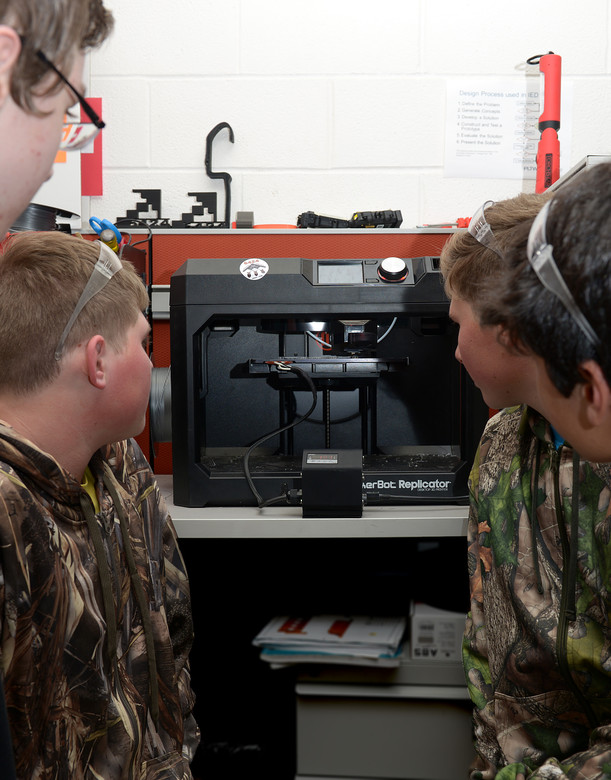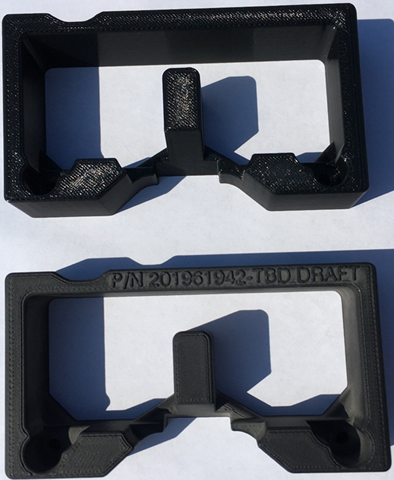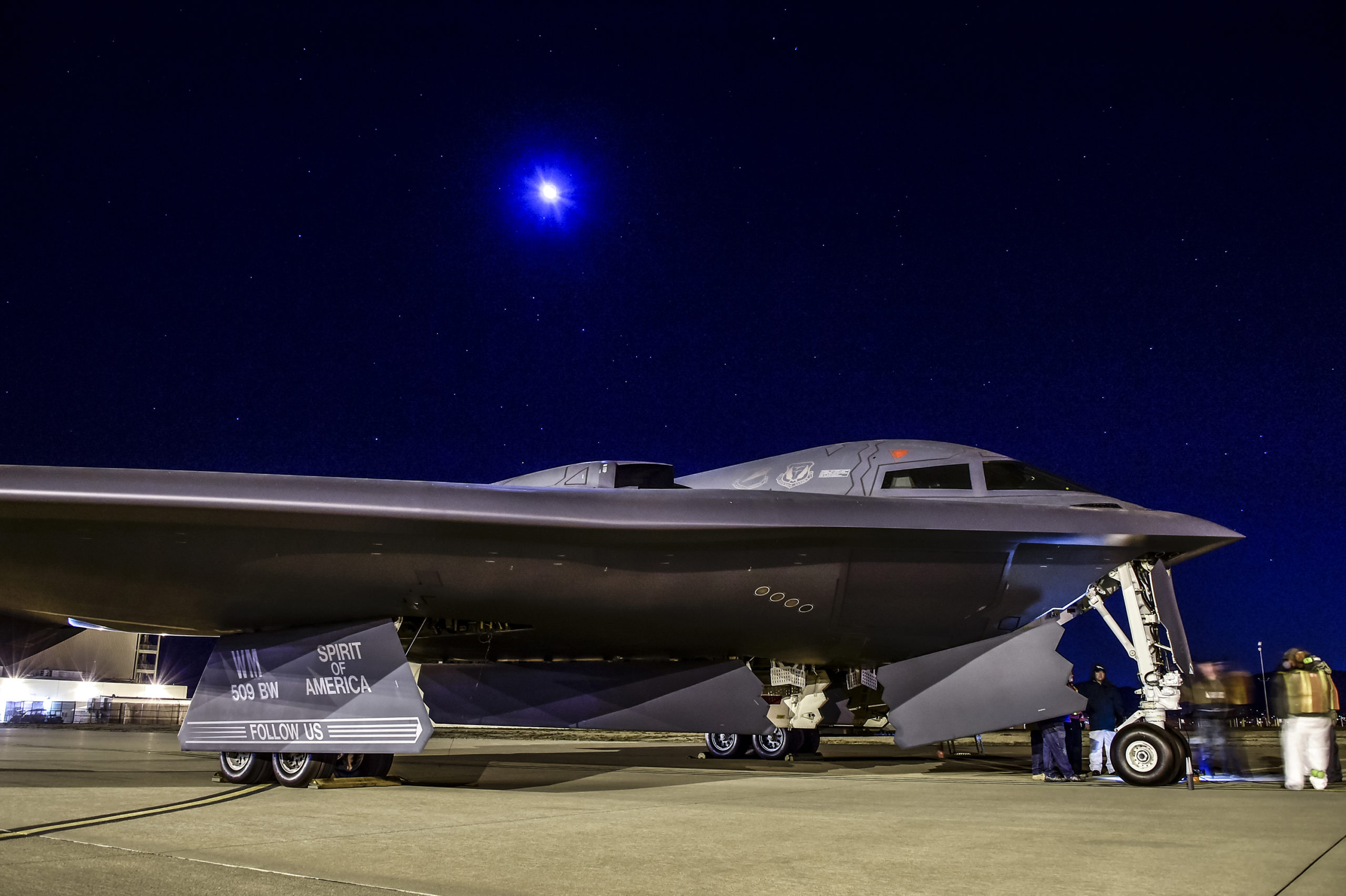The mission of the U.S. Air Force Life Cycle Management Center’s B-2 Program Office is to ensure the B-2 Spirit bomber jets stay relevant and in-flight through the early 2030s until replaced by its stealthier new version, the B-21s. To extend the life of the deadly aircraft and keep the existing B-2 bomber fleet ready and active for future missions, aerospace engineers at the B-2 Program Office turned to additive manufacturing. The technology was used to create a permanent protective cover that prevents the unintentional activation of the airframe mounted accessory drive (AMAD) decouple switch, which controls the connection of the engines to the hydraulic and generator power of the aircraft.
Each one of the 20 B-2 aircraft has a four-switch panel AMAD that sits on the left side of the two-person cockpit. When all switches are activated simultaneously, the crew has no choice but to eject as the aircraft will be without electrical and hydraulic power. In 2018, a B-2 jet was forced to make an emergency landing in Colorado Springs after the crew flipped one of the switches, forcing the B-2 Program Office to come up with an innovative solution to solve the critical issue.
At the time, B-2 pilot and commander of the 509th Bomb Wing at Whiteman Air Force Base in Missouri, John J. Nichols, turned to a team of students at Knob Noster High School, also in Missouri, that designed and 3D printed prototype AMAD panel covers in 72 hours at $1.25 a piece. Now, the B-2 Program Office has come up with 20 new additively manufactured covers that cost approximately $4,000 and will be delivered to the fleet in late 2020 or early 2021.

Students from the Knob Noster High School robotics team designed a protective panel that covers four switches in the cockpit of the B-2 Stealth Bomber (Image courtesy of US Air Force/ Sgt. Kayla White)
“Additive manufacturing is the way of the future,” said Roger Tyler, an aerospace engineer with the B-2 Program Office. “The B-2 is a low volume fleet. There’s only 20 of them, so anytime something needs to be done on the aircraft, cost can be an issue. But with additive manufacturing, we can design something and have it printed within a week and keep costs to a minimum.”
The development of the covers was aided by the Additive Manufacturing Design Rule Book, which was created by the Product Support Engineering Division, part of the U.S. Air Force Life Cycle Management Center (AFLCMC). According to Jason McDuffie, Chief of the Air Force Metals Technology Office (MTO), the rule book provides design guidelines and lessons learned in the additive manufacturing field, specifically the use of direct metal laser melting and fuse deposition modeling technologies, and has been applied to help create a variety of important parts for the Air Force.

3D printed protective cover for the airframe mounted accessory drive decouple switch in B-2 aircraft (Image courtesy of US Air Force Life Cycle Management Center)
“This part [AMAD cover] is unique, and there was never a commercial equivalent to it, so we had to develop it in-house,” Tyler added. “Additive manufacturing allowed us to rapidly prototype designs, and through multiple iterations, the optimum design for the pilots and maintainers were created. We have completed the airworthiness determination and are currently in the final stages to get the covers implemented on the B-2 fleet, which will be the first additively manufactured part to be approved and installed on the B-2.”
Originally created to evade radar detection and attack without warning from the Soviet Union’s command and control centers during the Cold War, no B-2’s have ever actually flown over Russian aerospace. Even so, over its 31-year life span, the B-2 Spirit bomber has been a veteran of several conflict operations, from Iraq and Afghanistan to the war in Kosovo, where it took out 33 percent of the Serbian targets in eight weeks. Described by its manufacturer, Northrop Grumman, as “practically indestructible”, the B-2 can fly 6,000 miles without the need to refuel, and the capacity to haul in excess of 20 tons of weapons in any weather completely undetected.
At $2.2 billion per aircraft, it is one of the most expensive warplanes ever made, capable of delivering large and precision-guided weaponry, both conventional and nuclear. Yet, up until now, the B-2 has only been used to drop non-nuclear bombs. For decades, experts have warned against deploying mission bombers with nuclear weapons that might trigger an accidental nuclear war, and this comes as no surprise, with nine nuclear-armed states possessing an estimated 13,400 weapons, the risk always remains latent – even more so with sophisticated bombers like B-2 that cannot be detected.
As the world’s only known stealth bomber, the aircraft continues to be a display of military force for the U.S., especially amid escalating tensions with countries like North Korea, China, and Russia. Recently, the B-2 Spirit bombers were deployed in the South China Sea amid a military exercise drill with troops practicing how to seize back the Andersen Air Force Base in Guam from an “invading” force; most likely as a response to China stepping up defensive military operations and exercises around Taiwan. In spite of its many years in the US Air Force fleet, the B-2 continues to be one of the most feared aircraft ever built, which is why sustainment modifications today remain an important aspect of the B-2 program, from coming up with cost-effective ways to repair and maintain the jets to teaming up with Northrop Grumman to ensure the units remain mission capable.
The U.S. Air Force often requires low-cost creative ways to replace parts on many of its aircraft. As such, it has already launched numerous research initiatives into additively manufacturing parts, from creating 3D printed replacement parts for F-35 fighter jets to saving thousands of dollars by using 3D printing to make cup handles and modify standard-issue gas masks. The latest 3D printed protective cover could become a great solution for an underlying problem that has already caused some havoc to B-2 pilots. For high operating cost aircraft like the B-2 (at a reported $122,000 per flight hour), repairs can be equally costly, but in-house production technologies like additive manufacturing can help aerospace engineers tasked with maintaining decades-old jets up to date and working as stealthily as they did 30 years ago.
Subscribe to Our Email Newsletter
Stay up-to-date on all the latest news from the 3D printing industry and receive information and offers from third party vendors.
Print Services
Upload your 3D Models and get them printed quickly and efficiently.
You May Also Like
Consolidation in AM: How 2025 Is Shaping the Industry’s New Normal
The first half of 2025 has been marked by a clear shift in the additive manufacturing (AM) industry. Companies are no longer just focused on developing new tech by themselves....
Etsy Design Rule Change Reduces Selection of 3D Printed Goods
Online marketplace Etsy has implemented a rule change requiring all 3D printed goods on the site to be original designs. The update to the site’s Creativity Standards states, ¨Items produced using...
U.S. Congress Calls Out 3D Printing in Proposal for Commercial Reserve Manufacturing Network
Last week, the U.S. House of Representatives’ Appropriations Committee moved the FY 2026 defense bill forward to the House floor. Included in the legislation is a $131 million proposal for...
Transforming From Tourist to Native: Duro CEO Michael Corr Explains Why the Company Rebuilt its PLM Software on AI
In these early innings of the AI boom, many market analysts have expressed concern that AI spend has gotten too far ahead of the technology’s proven ability to deliver significant...


































